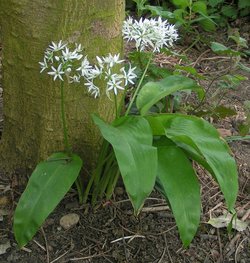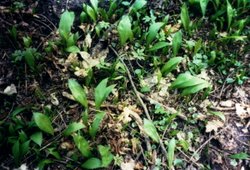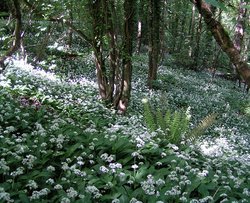Ramsons
|
|
| Ramsons | ||||||||||||||||||
|---|---|---|---|---|---|---|---|---|---|---|---|---|---|---|---|---|---|---|
| | ||||||||||||||||||
| Scientific classification | ||||||||||||||||||
| ||||||||||||||||||
| Binomial name | ||||||||||||||||||
| Allium ursinum |
Ramsons, buckrams or bear's garlic (Allium ursinum) is a wild relative of chives. The systematic name derives from the fact that brown bears like to eat the bulbs of the plant and dig up the ground to get at them, as do wild boar.
Wild onions grow mainly in swampy deciduous woodlands. They flower before the trees get their leaves and fill the air with their characteristic strong smell.
The leaves are collected and eaten as salad, boiled or as a kind of pesto. They were used as fodder as well. Cows that have fed on ramsons give milk that slightly tastes of garlic, and butter made from this milk used to be very popular in 19th century Switzerland.
The first evidence of the human use of ramsons comes from the mesolithic settlement of Barkaer (Denmark) where an impression of a leaf has been found. In the Swiss neolithic settlement of Thayngen-Weier (Cortaillod-culture) there is a high concentration of ramsons pollen in the settlement layer, this has been interpreted as evidence for the use of ransoms as fodder.
Ramsons have recently become very popular in Germany, and the town of Eberbach hosts an annual ramsons fair in March and April.
External links
- Ramson at Gernot Katzer's Spice Pages (http://www.uni-graz.at/~katzer/engl/Alli_urs.html)
Missing image Ramsons_close_700.jpg A close-up of the flowers and developing fruit |



